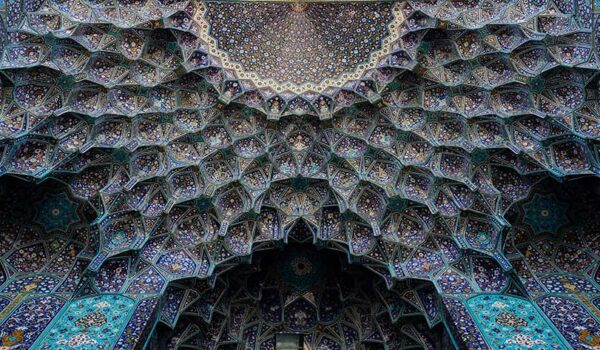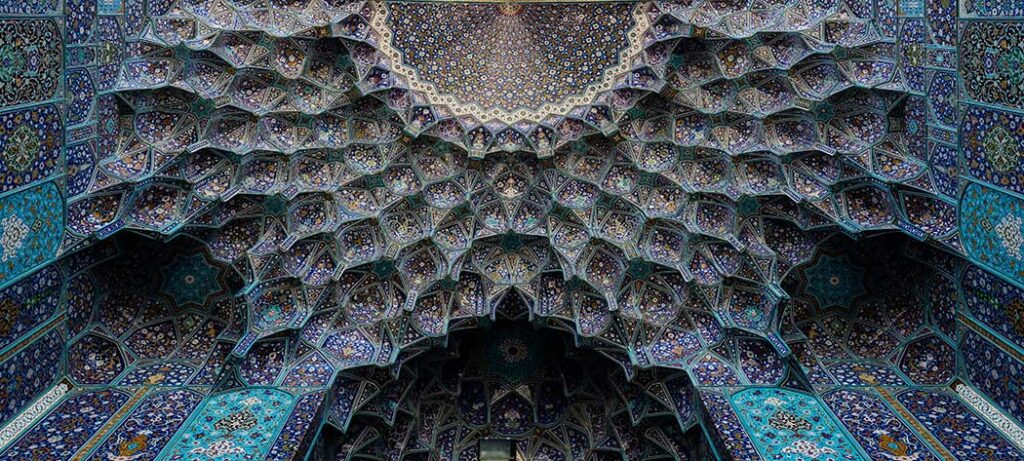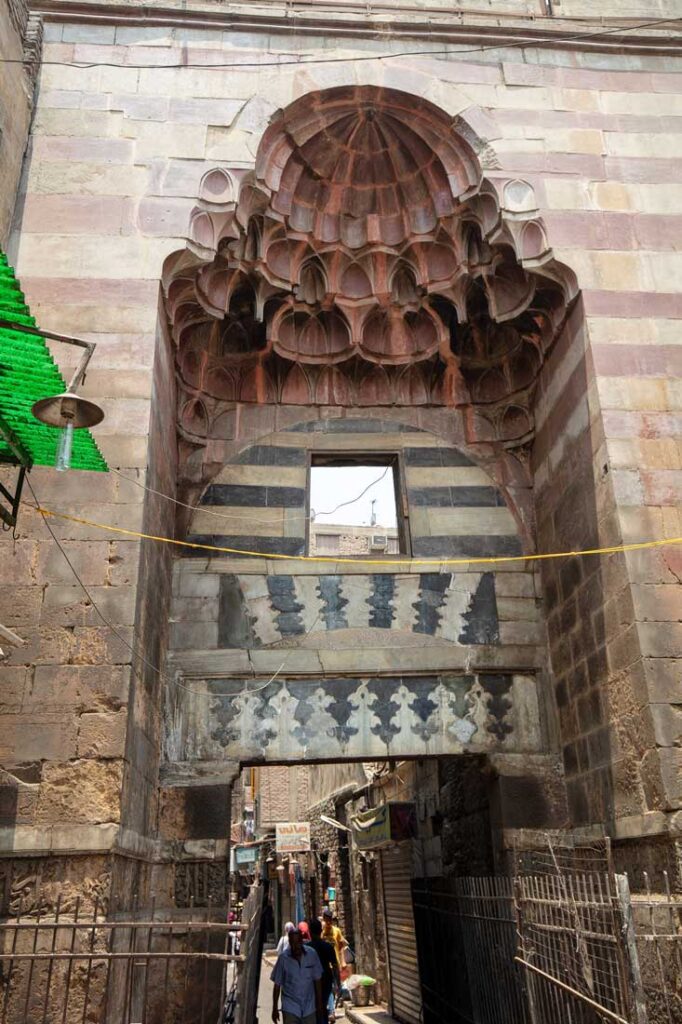Muqarnas: The Art and Science of Islamic Architectural Ornamentation

1. Introduction

Muqarnas is a distinctive architectural feature in Islamic and Arabic architecture, characterized by intricate, three-dimensional, honeycomb-like designs. These decorative elements are commonly found in domes, vaults, entrance portals, and minarets, serving both aesthetic and structural purposes. Muqarnas showcases the ingenuity of Islamic architectural craftsmanship, merging mathematical precision with artistic beauty. This article explores its historical origins, global applications, construction techniques, cognitive effects, and continued relevance in contemporary architecture.
2. Historical Origins and Evolution

2.1. Early Development
The origins of muqarnas can be traced back to the 10th century, emerging in Persia and Mesopotamia under the Buyid and Seljuk dynasties. These early forms were relatively simple, serving as a means to transition from square bases to circular domes. Over time, muqarnas became increasingly complex, evolving into an essential element of Islamic architecture.
2.2. Expansion Across the Islamic World
Muqarnas spread rapidly across the Islamic world, adapting to different architectural styles and regional influences:
- Persia & Central Asia: Persian architects refined muqarnas, incorporating intricate tilework and colorful mosaics, seen in the Shah Mosque in Isfahan.
- Arab World & North Africa: The Fatimids, Ayyubids, and Mamluks extensively used muqarnas in mosques and palaces, as seen in Cairo’s Sultan Hassan Mosque.
- Andalusia & the Maghreb: The Moors introduced stunning muqarnas vaulting in the Alhambra in Granada, one of the most celebrated examples.
- Ottoman Empire: Ottoman architects integrated muqarnas into their grand mosques, such as the Süleymaniye Mosque in Istanbul.
3. Structural and Decorative Aspects of Muqarnas
3.1. Architectural Function
Muqarnas plays a crucial role in architectural design by:
- Facilitating the transition between different geometric shapes, such as squares and domes.
- Distributing weight efficiently, contributing to the overall stability of a structure.
- Enhancing acoustic properties by diffusing sound evenly within domes and vaults.
3.2. Aesthetic and Symbolic Aspects
Beyond functionality, muqarnas embodies Islamic artistic philosophy, representing:
- Divine infinity through repetitive geometric patterns.
- Light and shadow interplay, enhancing the spiritual atmosphere of religious spaces.
3.3. Materials and Construction Techniques
Muqarnas is crafted from a variety of materials, including:
- Stone (common in Persia and the Ottoman Empire).
- Plaster/stucco (favored in North Africa and Andalusia for its intricate detailing).
- Wood and brick (used in Central Asian and Iranian architecture). Traditional artisans employed mathematical precision in designing muqarnas, relying on geometric principles and modular repetition.
4. Muqarnas, Fractals, and Cognitive Effects
4.1. Fractal Geometry in Muqarnas
Muqarnas follows fractal patterns, which are self-repeating and scale-invariant, meaning smaller parts resemble the whole. These fractal structures create a sense of order, complexity, and harmony, reflecting mathematical beauty in nature. The repetition of geometric elements in muqarnas aligns with fractal principles seen in Islamic art and architecture.
4.2. Psychological and Cognitive Impact
Studies on fractal aesthetics suggest that exposure to fractal-based designs can have a calming effect on the human brain, reducing stress and promoting mental well-being. Muqarnas, with its structured complexity, provides:
- Visual comfort by offering a sense of familiarity through self-repetition.
- Cognitive engagement, encouraging deep observation and contemplation.
- Spiritual elevation, as seen in religious architecture where muqarnas directs focus upwards, symbolizing a connection to the divine.
4.3. Neuroscience and Architectural Experience
Research in cognitive architecture suggests that structured, rhythmic patterns like those found in muqarnas influence brain activity positively. The brain processes repetitive geometries efficiently, leading to a sense of tranquility and cognitive ease. This aligns with the biophilic design principles, which advocate for patterns found in nature to enhance human experience.
5. Global Influence and Adaptations
5.1. Muqarnas Beyond the Islamic World
Muqarnas influenced architectural styles beyond the Islamic world:
- Byzantine and Gothic architecture adopted similar ribbed and vaulted structures.
- Orientalist and neo-Islamic styles in Europe and America incorporated muqarnas-inspired elements.
5.2. Muqarnas in Contemporary Architecture
Modern architects have revived muqarnas using advanced parametric design and digital fabrication, allowing for:
- 3D-printed muqarnas structures in experimental architecture.
- Integration in modern Islamic architecture, maintaining tradition while embracing new technologies.
6. Notable Examples of Muqarnas Architecture
- Iran: Shah Mosque, Isfahan – Known for its spectacular blue-tiled muqarnas vaulting.
- Spain: Alhambra, Granada – One of the most famous examples, showcasing intricate stucco work.
- Egypt: Sultan Hassan Mosque, Cairo – Features grand muqarnas entrance vaults.
- Turkey: Süleymaniye Mosque, Istanbul – Displays Ottoman refinements of muqarnas design.
- Iraq: Great Mosque of Samarra – One of the earliest applications of muqarnas.
7. Challenges and Preservation Efforts
Many historic muqarnas structures face threats due to environmental degradation, earthquakes, and urbanization. Conservation efforts include:
- Digital documentation using 3D scanning and modeling.
- Restoration initiatives led by UNESCO and cultural heritage organizations.
- Training artisans to preserve traditional craftsmanship.
8. Conclusion
Muqarnas stands as a testament to the artistic and mathematical brilliance of Islamic architecture. Its historical depth, structural ingenuity, and aesthetic beauty continue to inspire architects worldwide. Whether in ancient mosques or contemporary digital designs, muqarnas remains a vital element of architectural heritage and innovation. Future developments in digital fabrication and heritage conservation will ensure its enduring legacy for generations to come.
